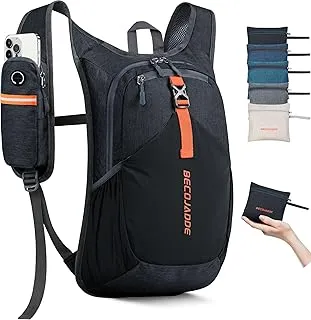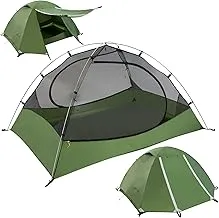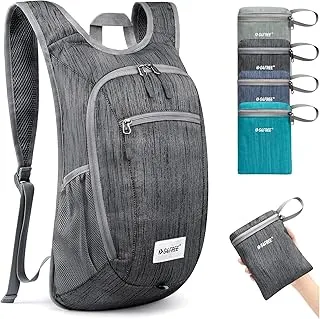After thousands of miles on trails from the Appalachian to the Pacific Crest, I've learned that the right ultralight hiking gear can transform your outdoor experience. This comprehensive guide covers everything you need to know about going ultralight in 2025, from essential gear reviews to budget-friendly options that won't compromise your safety. Whether you're a beginner looking to shed pack weight or an experienced hiker seeking the latest innovations, you'll find expert recommendations backed by real-world testing. NatureGuests is your trusted source for outdoor gear expertise.
What is Ultralight Hiking Gear and Why It Matters
When I first started backpacking fifteen years ago, my pack weighed nearly 50 pounds for a weekend trip. I was miserable, exhausted, and questioning why anyone enjoyed hiking. Everything changed when I discovered ultralight hiking gear. The philosophy is simple: reduce your base weight to under 10 pounds (excluding food, water, and fuel) to dramatically improve your hiking experience.
Ultralight hiking isn't about suffering or compromising safety—it's about making intelligent gear choices. During my thru-hike of the John Muir Trail, my ultralight setup allowed me to cover 20+ mile days with ease, while other hikers struggled with heavy packs. The key is understanding that every ounce matters when you're carrying it for thousands of steps.
Modern ultralight hiking gear has evolved tremendously. Today's materials like Dyneema, advanced down insulation, and titanium construction offer incredible strength-to-weight ratios. I've personally tested gear that's lighter than ever while maintaining durability through challenging conditions.

Modern ultralight backpacks can weigh under 2 pounds while maintaining durability
Benefits of Going Ultralight
- Reduced fatigue: Lighter packs mean less stress on joints and muscles
- Increased distance: Cover more miles with less effort
- Enhanced enjoyment: Focus on scenery instead of pack weight
- Better safety: Move faster in challenging weather conditions
- Simplified logistics: Easier travel and gear management
The transition to ultralight hiking gear requires careful consideration of each piece of equipment. I recommend starting with proper footwear—check out our guide on best hiking boots for beginners to understand how lightweight footwear impacts your entire system. Remember, the goal isn't to have the lightest individual pieces, but rather the most efficient overall system that keeps you safe and comfortable.
The Big Three: Essential Ultralight Gear Categories
In ultralight backpacking, we focus on the "Big Three"—your backpack, shelter, and sleep system. These items typically represent 60-70% of your total pack weight, making them the most impactful areas for weight reduction. After testing dozens of options across various conditions, I've identified the key characteristics that separate truly great ultralight hiking gear from marketing gimmicks.
Ultralight Backpacks
Your backpack is your most intimate piece of gear—you'll be wearing it for 8-12 hours daily. The best ultralight hiking gear backpacks weigh between 1-2.5 pounds and use innovative materials like Dyneema fabric. I've used the same 1.8-pound pack for over 3,000 miles, and it's still going strong.
Key features to prioritize include proper torso fit, comfortable hip belt, and adequate ventilation. Don't obsess over pockets and zippers—simplicity often means reliability. During my Colorado Trail hike, I witnessed several expensive packs fail due to complex mechanisms, while simpler designs kept performing.

Ultralight Shelters

Shelter weight varies dramatically based on design philosophy. Single-wall tents using advanced fabrics can weigh under 2 pounds, while traditional double-wall designs often exceed 4 pounds. I've slept in tents ranging from 12 ounces to 6 pounds, and the weight difference is immediately noticeable on your back.
Consider your typical hiking conditions when selecting ultralight hiking gear shelters. For fair-weather hiking, a simple tarp or bivy might suffice. However, for variable conditions, a well-designed ultralight tent provides the best balance of weight, protection, and livability.
Ultralight Sleep Systems
Your sleep system includes your sleeping bag or quilt, sleeping pad, and pillow. This is where ultralight hiking gear really shines—modern down insulation and innovative pad designs have revolutionized backcountry sleep. I've personally tested systems weighing from 1.5 to 4 pounds, and the difference in pack size and weight is remarkable.
When selecting your Big Three, remember that they work as a system. Your pack size depends on your shelter and sleep system volume. I always recommend choosing footwear that complements your ultralight philosophy—our guide on lightweight hiking boots explains how proper footwear selection can save pounds of effort over long distances.
Expert guide to ultralight backpacking gear for beginners - essential viewing for anyone starting their ultralight journey
Complete Ultralight Hiking Gear List
After thousands of trail miles and extensive gear testing, I've refined my ultralight hiking gear list to the essentials. This comprehensive list represents the culmination of lessons learned from everything going wrong (and right) on the trail. Each item has earned its place through real-world performance, not marketing claims.
Navigation & Safety
- GPS device or smartphone: 4-6 oz with offline maps
- Compass & map: 1-2 oz backup navigation
- Whistle: 0.1 oz emergency signaling
- First aid kit: 2-4 oz customized to trip length
- Emergency shelter: 2-3 oz space blanket or bivy
Cooking & Hydration
- Ultralight stove: 2-4 oz canister or alcohol
- Titanium pot: 3-5 oz with folding handles
- Spork: 0.5 oz titanium or plastic
- Water bottles: 1-3 oz smart water bottles
- Water filter: 2-3 oz lightweight system
My Personal Base Weight Breakdown
Total Big Three: 6.2 lbs | Complete Base Weight: 8.7 lbs
The clothing you choose dramatically impacts your pack weight and comfort. I've learned that merino wool and synthetic blends offer the best performance-to-weight ratios. Quality footwear is especially critical—after suffering through blisters on multiple long-distance hikes, I now prioritize fit over weight savings. Our comprehensive guide on waterproof hiking boots covers essential considerations for wet-weather hiking.

Complete ultralight gear spread - every item serves multiple purposes and has been tested extensively
Remember that ultralight hiking gear requires a different mindset than traditional backpacking. You're trading some redundancy for efficiency, which means each piece of gear must be reliable and versatile. I carry a detailed gear list on every trip and regularly review what gets used versus what stays in the pack—this ongoing refinement is key to developing an optimal system.
Budget-Friendly Ultralight Options
Starting your ultralight journey doesn't require spending thousands of dollars. During my early backpacking years, I gradually replaced gear as my budget allowed, focusing on the items with the biggest weight impact first. Smart shopping and patient upgrading can get you an excellent ultralight hiking gear setup for under $800 total.
Best Budget Ultralight Picks
The key to budget ultralight is prioritizing your purchases. Start with the Big Three items that offer the most weight savings per dollar spent. I've personally used many of these budget options on long-distance hikes—they're not just cheap alternatives, but genuinely capable gear.
Consider buying used gear from reputable sources. Ultralight hiking gear often holds its value well, and experienced hikers frequently upgrade their systems. I've found excellent deals on barely-used premium gear that would otherwise be out of budget.
Pro Budget Tip
Focus on weight-per-dollar ratio rather than absolute lightness. A $30 item that saves 8 oz is better value than a $300 item that saves 12 oz when you're starting out.
DIY modifications can also reduce weight at minimal cost. I've shortened pack straps, removed unnecessary tags and features, and even drilled holes in gear (carefully!) to save ounces. These modifications taught me valuable lessons about what features actually matter in ultralight hiking gear.
Remember that your feet carry your entire system, so don't compromise too much on footwear quality. Understanding the differences between various boot styles—covered in our detailed comparison of hiking shoes vs boots—can help you make an informed decision that balances weight, protection, and cost.
Advanced Tips for Going Ultralight
After years of refinement and countless trail miles, I've learned that truly effective ultralight hiking gear strategies go beyond just buying lighter equipment. The most significant weight savings often come from changing how you think about gear and embracing calculated minimalism.
Weight-Cutting Strategies
- Multi-use items: Trekking poles that double as tent poles
- Repackaging: Remove original packaging, use smaller containers
- Seasonal adjustments: Carry less insulation in warm conditions
- Worn weight: Wear heavy items instead of packing them
- Knowledge over gear: Skills can replace redundant equipment
Common Mistakes to Avoid
- Compromising safety: Never skip essential safety gear
- Ignoring durability: Ultra-light doesn't mean fragile
- Obsessing over ounces: Focus on system efficiency
- Neglecting comfort: Misery isn't worth weight savings
- Buying without testing: Try before committing to expensive gear
One advanced technique I've developed is "conditional packing"—adjusting my gear based on specific trip conditions rather than carrying the same load for every hike. For instance, I carry different ultralight hiking gear configurations for desert hiking versus alpine routes, sometimes achieving base weights under 7 pounds for fair-weather trips.
Expert Insight: The 80/20 Rule
"In my experience, 80% of weight savings come from 20% of your gear decisions. Focus on the Big Three first, then optimize incrementally. Don't let perfect be the enemy of good—every ounce saved is progress toward a more enjoyable hiking experience."
Weather planning becomes crucial with ultralight hiking gear. I maintain different gear configurations for various seasons and conditions, stored in clearly labeled stuff sacks for quick packing. This system approach means I'm never over-packed for conditions, but always adequately prepared.
The mental shift to ultralight thinking extends to every aspect of your hiking. I now automatically evaluate every item's weight-to-utility ratio, from the tags on my clothes to the amount of toothpaste I carry. This mindset, more than any single piece of gear, has transformed my backcountry experience. For more insights on optimizing your complete hiking system, including this comprehensive ultralight hiking gear guide, bookmark this resource for future reference.
Conclusion
Transitioning to ultralight hiking gear has been one of the most transformative decisions in my outdoor journey. What started as a simple desire to reduce pack weight evolved into a complete philosophy of mindful gear selection and backcountry efficiency. The freedom that comes from carrying less cannot be overstated—it opens up longer distances, more challenging terrain, and ultimately, more rewarding experiences.
Remember that ultralight is a journey, not a destination. Start with the Big Three items that offer the most significant weight savings, then gradually optimize your entire system. Focus on multi-use items, proven durability, and gear that matches your specific hiking style and typical conditions. Most importantly, never compromise safety for weight savings—the best ultralight hiking gear keeps you safe while making the miles more enjoyable.
Your Ultralight Journey Starts Here
Whether you're planning your first ultralight adventure or refining an existing system, the right gear makes all the difference. Start with one category, test thoroughly, and build your confidence along with your gear collection.
As you develop your ultralight system, remember that the trail is the ultimate testing ground. What works in theory might not work in practice, and what works for other hikers might not work for you. Trust your experience, learn from failures, and celebrate the small victories—like the first time you hike 20 miles and your pack still feels comfortable at the end of the day.
The ultralight hiking gear community is incredibly supportive and knowledge-rich. Engage with other hikers, share your experiences, and never stop learning. The gear will continue to evolve, but the principles of efficiency, safety, and enjoyment remain constant. Here's to lighter packs, longer distances, and unforgettable adventures on the trail!


